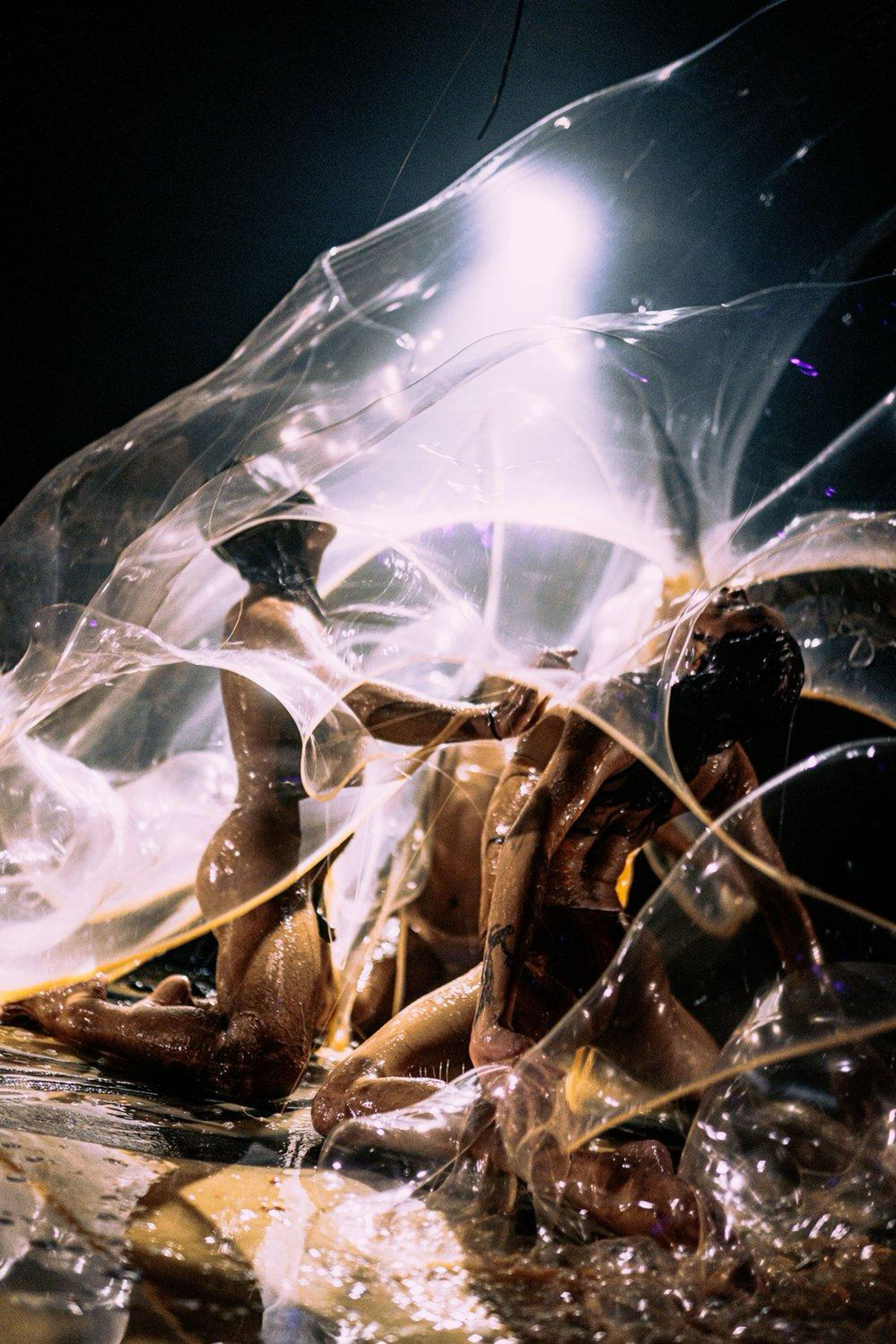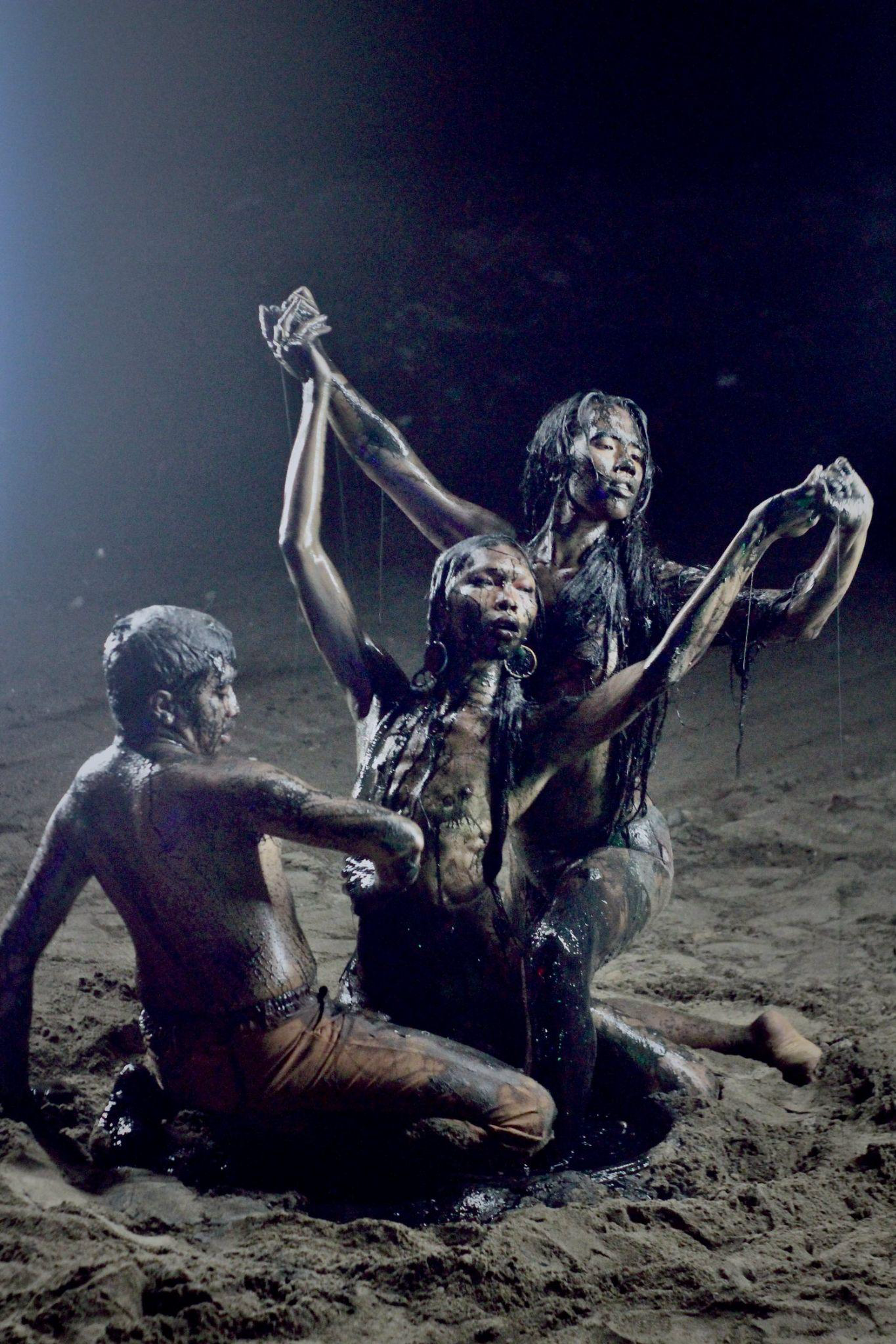Over the past few years, I have been researching and developing Cosmological Gangbang—a multifaceted project consisting of three works in a variety of media, ranging from painting to drawing, film, performance, and installation: Timawo (2021), Creation Paradigm and VOID (2022), and PEARLS (2023). In this essay, I draw from my master's thesis, “Cosmological Gangbang: Queer Spirituality in Relation to Ecology,” (2022) as well as a series of observations and notes from a recent research trip to the Philippines taken in 2023, to discuss my search for an ancestral identity.

Joshua Serafin, PEARLS, 2023. Performance, performed by Joshua Serafin, Lukresia Quismundo, and Bunny Cadag. Photo by Michiel Devijver and Maryan Sayd.
In the Philippines, the binary representation of gender was established by Spanish colonizers and Western oppressors. Yet, in the precolonial Philippines, shamans were considered to be the leaders and central figures in society. They took on the role of caretakers, attending to the physical and spiritual needs of the community. They were flexible and fluid in gender, and played different roles in society. Depending on which region they lived in, shamans might be referred to as albularyo, mananambal, daetan, babaylan, belian, or mambunong. As Francisco R. Demetrio and Gilda Cordero-Fernando write in The Soul Book: Introduction to Philippine Pagan Religion:
[The shaman’s] office is focused directly on achieving the psychic balance of her community. She is essentially a person in the service of others. Her healing powers, her ecstasy whereby she goes out in search of the soul of the sick person in order to guide it back to its body and to health, or her journey to conduct the soul of the dead to the land of death; her clairvoyance and ability to read the secrets of men’s hearts, her reputed wisdom in counseling, her dramatic talents that enable her audience to participate in celestial and under-worldly experiences, her easy tolerance of the extremes of heat, and cold, here struggles with demons and the spiritual foes of her people, her ease in contacting the supreme being and the spirit world—all are meant to strengthen and support the spiritual life of the community.1
Colonizers failed to undermine the role of the shamans in Filipino society due to the deeply embedded practices of our ancestors. Instead, they rewrote the narrative, designating our spirits as demonic entities and promoting the belief that salvation could only be achieved by embracing Catholicism. However, indigenous belief systems—guided by local shamans whose genders are not only fluid but also, as Demetrio and Cordero-Fernando’s account suggest through their use of the pronouns “she/her,” transfeminine—continue to thrive and be renewed. This potential of queer, indigenous practices, and their relationship to the land and ecology, have guided much of the work I discuss here.
I propose, then, to start with the following question: How do we understand the role of technology within indigenous lands and life? Technology, as it is most commonly understood, would seem to contradict the subjects I am currently researching in my practice: cosmology as a form of ecology, queerness, and indigeneity. Technology relies on the extraction from and destruction of nature and indigenous lands to produce the mechanisms and hardware we live with, and capitalist systems underlie the devices that make and accelerate our lives, such as phones and computers. The current technology not only fails to preserve nature but acts as a consumerist destructive machine.
But we can look back to other definitions of technology to recover strategies for conserving and preserving life. While conducting research in the last few years, my collaborators and I visited the Manobo-Talaandig peoples in Bukidnon—an indigenous community that was able to preserve their practices and culture in their ancestral lands, located in the mountains in the center of the island of Mindanao. Their remove from more populated areas of the island, the topography of the landscape, and the presence of Muslim communities in this area have helped to protect them from the political and religious methodologies imposed by Spanish colonizers. My observations and perspective here are, of course, that of a stranger entering the community as an invited guest, and my words cannot fully represent their practices. However, what was clear to me in spending time within the Manobo-Talaandig community is that their cultural identity is deeply rooted in spirituality, ecology, gender, sexuality, and the physical body, all understood as one rather than as separate entities.
Their belief system is expressed through their relationship to and stories about their gods, goddesses, and spirit guides, as well their mutual respect for the unseen and nonphysical world, all of which play a significant and inextricable role in their daily lives. They know that human existence is one among other forms of existence within their ancestral lands, and they acknowledge that there are beings far more powerful than them. These belief systems can be understood as an indigenous technology far more advanced than any form of technology Western societies are trying to develop. Theirs is a technology that helps preserve nature and life, fosters mutual respect, and strengthens a relation to a larger cosmology. It is a technology of symbiotic existence.

Joshua Serafin, Creation Paradigm (still), 2022. Three-channel video, 25 minutes. Pictured: Bunny Cadag, Lukresia Quismundo, and Alaga.
These technologies that operate against capitalist structures, heteronormative, binary thinking, and extractive practices are critical to the survival and flourishing of nature, gender, and spirituality, and especially of the existence and presence of gender diversity within the archipelago. Spending some time with the Manobo-Talaandig opened my eyes to the deeply powerful anti-colonial tool that is their belief system.
My trip to Mindanao also served as the final research phase for both Cosmology and PEARLS.
PEARLS—which premiered in Viernulvier in Ghent, Belgium and will tour throughout Europe and Asia in the coming year — is the third and final iteration of the cosmology I have been developing. This hour-long multimedia performance, produced in collaboration with Lukresia Quismundo and Bunny Cadag, draws inspiration from nonnormative genders celebrated in the precolonial Philippines. We, the artists, abandon the binary we have inherited from colonial culture and return to the ancient past in search of the spiritual roots of Filipino society. With a gaze oriented toward and away from imperial history, the three performers advance gender-diverse existence as an alternative blueprint for the future. PEARLS thus becomes an exercise of healing that offers an opportunity for queer and trans people of color to transfigure dark and traumatic histories into something beautiful, similar to pearls, which are formed from foreign particles that irritate the oyster’s mantle.
Our excursion with the Manobo-Talaandig community deeply informed the development of PEARLS, yet we were very careful not just to visit the community and freely take their stories (the extractive colonizer mindset). Instead, we visited with the intention to feel and experience the spirits and energies surrounding the lands. Living with the Manobo-Talaandig people, observing their rituals, and hearing their stories, passed down for half a millennium was like a journey through the badlands to enter the spirit world: we had to learn who our own spirit guides were through these experiences.
We had the opportunity to speak with Datu Arayan, the current Baylan of the community, who told us about the lives we had once lived, the deaths our bodies had gone through, the journeys our spirits had undergone in the afterlife, and those that led to our reincarnations into the lives we currently live. We realized that our souls have always been intertwined, that our journey now has already been written. As an artist, a choreographer, a human being, and a Filipino, I felt connected to a life that transcended the ruptured temporality brought about by colonization. This journey has connected me to my ancestral body through the deep ancestral knowledge that I have always been searching for.
During our research and creation process, we were engaged in a constant battle to work with nature, the mountains, the sea, and the desert winds; we could not control them, as we tend to try to do. Everything shifted and became easier once we let go and found the flow and energy that nature proposed. When we shifted perspective, everything changed: we cannot control the waves, or the wind that gushes toward the sea. We cannot control and moderate the fire once we have started it, nor can we control and soften the soil. But what we can do is listen and adapt to what nature offers.
Working with nature presents an opportunity to change our relationship to the environment. If we understand that our human perception is one among many paradigms—not the rule but one kind of measure—then we will experience a better and easier way of existing. We can apply this same understanding to our perspective toward sexuality and gender. If we allow ourselves to adapt, how too could our society change? Plants allow themselves to transform for their species to survive; penguins “forget” their sexuality when they are called upon to co-parent an abandoned egg whose parent didn’t survive the hunt. Self-sacrifice, changing gender roles—these are ways to survive, processes for liberating ourselves from the norms that society has put into place. Queerness and transness have always existed to survive.
Jaya Jacobo writes of transfemininity, bringing us back to the figure of the shaman: “The binabayi is a gender that has always been there, but as this genealogy of transfeminine knowledge tells us, she is now upon us, here and elsewhere.”2 I consider queer people as contemporary shamans with the same status as babaylans in the precolonial Philippines and, by extension, among indigenous communities. These contemporary shamans liberate and heal our society from the current dimorphic structures put in place and reinforced by Western societies. Queerness is not only about identity and representation, it also proposes a state of in-betweenness in thought, in action, that allows a more expansive approach to and perspective on life. The right to be non-binary should be the norm: as humans, we can and should become who we want to be, beyond the structures we have built in our society, beyond what we have considered normal for the past five hundred years since the Spanish colonization of the Philippines. My work hopes to find its way to our ancestral body, our rooted identity, by decolonizing ourselves from normative ideologies and reclaiming the fact that we all came from nature and that nature and ecology are queer. We are queer ecology: the earth is and should be the primary source of knowledge.

